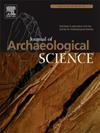明代(公元1368-1644年)武当山官方建筑琉璃瓦的来源研究:来自武龙宫和老君殿的见解
IF 2.5
1区 地球科学
Q1 ANTHROPOLOGY
引用次数: 0
摘要
武当山古建筑群是明代的皇家道教建筑,共有20,000多座建筑。需求量巨大的建筑琉璃瓦是从外地运来的还是就地生产的问题,反映了皇家建筑工程琉璃瓦生产和原材料供应的组织体系。采用WDXRF、HR-ICP-MS、TIMS等方法对武龙宫和老君殿釉面砖进行分析,对釉面砖体的主、次、微量元素及釉面层铅同位素比值进行表征。该结果排除了所研究的琉璃瓦样品来自Pangwan窑(武当山官方琉璃瓦供应商)的可能性。此外,当与来自明朝帝王都城和官窑的琉璃瓦数据进行比较时,很明显这些参考样本与武龙宫和老君殿的琉璃瓦并非同一来源。铅同位素分析表明,武龙宫和老君殿使用的铅可能来自鄂西地区。这一探索性研究有助于揭示明代皇家工程的组织体系和主导供应网络,同时也为未来明朝建筑的修复提供参考。本文章由计算机程序翻译,如有差异,请以英文原文为准。
Provenance study of the official architectural glazed tiles of Wudang Mountain in the Ming Dynasty (1368–1644 CE): Insights from Wulong Palace and Laojun Hall
Wudang Mountain ancient building complexes were royal Taoist buildings during the Ming Dynasty, comprising over 20,000 structures. The question of whether the architectural glazed tiles in huge demand were transported from other regions or produced locally reflects the organizational system of glazed tile production and the supply of raw materials in royal architectural engineering. Glazed tiles from Wulong Palace and Laojun Hall were analyzed, using WDXRF, HR-ICP-MS, and TIMS to characterize both the major, minor, and trace elements of the body and the lead isotope ratios of the glaze layer. The results exclude the possibility that the studied glazed tile samples originate from the Pangwan Kiln (an official glazed tile supplier for Wudang Mountain). Furthermore, when compared with glazed tile data from the Ming Dynasty imperial capitals and official kilns, it is clear that these reference samples do not share the same origin as those of Wulong Palace and Laojun Hall. Lead isotope analysis suggests that the lead used for Wulong Palace and Laojun Hall likely originated from western Hubei. This exploratory study contributes to revealing the organizational system and lead supply network of imperial engineering in the Ming Dynasty while providing a reference for the future restoration of Ming architecture.
求助全文
通过发布文献求助,成功后即可免费获取论文全文。
去求助
来源期刊

Journal of Archaeological Science
地学-地球科学综合
CiteScore
6.10
自引率
7.10%
发文量
112
审稿时长
49 days
期刊介绍:
The Journal of Archaeological Science is aimed at archaeologists and scientists with particular interests in advancing the development and application of scientific techniques and methodologies to all areas of archaeology. This established monthly journal publishes focus articles, original research papers and major review articles, of wide archaeological significance. The journal provides an international forum for archaeologists and scientists from widely different scientific backgrounds who share a common interest in developing and applying scientific methods to inform major debates through improving the quality and reliability of scientific information derived from archaeological research.
 求助内容:
求助内容: 应助结果提醒方式:
应助结果提醒方式:


